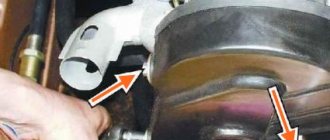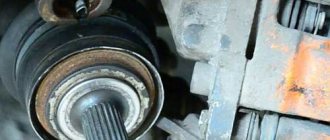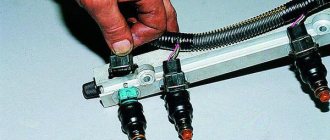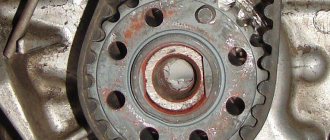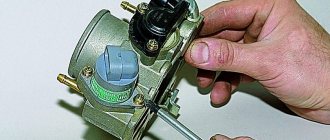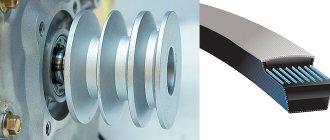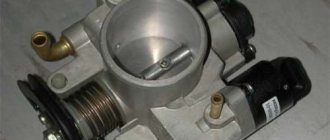How to replace the crankshaft position sensor on a VAZ 2108-VAZ 21099?
Removal: 1) First, de-energize the battery by disconnecting the “-” terminal from the battery itself. (Do you want to know in detail how to remove the “-” terminal? Then, in this case, for all the information on this matter, see the article: “Replacing the battery on a VAZ”, point “1”)
2) Next, holding the wire block with your hand, disconnect it from the crankshaft position sensor.
3) Then remove the single bolt that secures the crankshaft sensor to the bracket on the engine.
4) After you unscrew one single bolt, remove the crankshaft position sensor from the bracket.
Installation: 1) Installation occurs in the reverse order of removal.
Checking the functionality of the crankshaft position sensor:
1) First you will need to connect a “multi-meter” to the removed crankshaft position sensor. 2) And then check the crankshaft position sensor for resistance.
Note! If the crankshaft position sensor is fully operational, the “ohmmeter” should show you a result of “550-750” Ohms!
You may also like
Crankshaft position sensor and its replacement
This material will be useful to all owners of VAZ 2109, 2108 and 21099 cars with injection engines, since it is on such models that a crankshaft position sensor is installed from the factory.
DPKV is the part that you should have in stock at any time. If you find yourself on the road due to the failure of this spare part, then you may not even start the engine, and the only way to get home is a tow truck or tow truck.
The price of a crankshaft sensor for a VAZ 2109 ranges from 300 to 500 rubles, depending on the type, part code and manufacturer.
Symptoms of malfunction
The problems that can arise as a result of a sensor malfunction are different. Below are some of the possibilities:
- no spark
- the car won't start
- RPM drops when driving or idling
Replacing DPKV with your own hands + video review
In order not to show everything on the fingers and not to explain the whole process once again, I made a detailed video review, which shows the procedure most clearly. Even a novice driver can figure it out, since there are no difficulties in it. The main thing is to have the following tool at hand:
- head for 10
- ratchet or wrench
- small extension cord
Here is a review of how to replace the crankshaft position sensor on VAZ 2109, 21099, 2108
The review was written using the example of a 1.5 liter VAZ 2111 engine.
If, as a result of viewing, you still have any questions, you can ask them under the article in the comments. Or follow the link to the video and ask on the channel.
Replacement of battery cable terminals on all VAZ vehicles
Hello. The crankshaft sensor failed today, now I’m going to go get a new one, how much can I expect when purchasing this sensor? Thank you in advance for your response.
Hello Gleb! A new crankshaft position sensor will cost you around 200-450 rubles!
Good day! I bought DPKV 37.3847 2112-3847010 yesterday. I measured it with an ohmmeter on the new sensor and showed 910 ohms. I measured the old one and it shows 710 ohms. I replaced the sensor I bought with a similar one and measured it and it also shows 915 ohms. Is this normal for this sensor or is it defective?
Guys wanted to change the crankshaft sensor but broke the place where it is attached. How can I replace it or weld it?
Hello Roma! Either weld as you said, or use some very strong glue, or buy a new camshaft cover on which this bracket will already be, but only if you decide to weld, then do it so that the distance is maintained and the bracket fits in exactly this place!
Hello. Please tell me. I have a VAZ 21099 injector. If you get into even a minor puddle, the car starts to stall, barely holds idle and does not drive for some time. You can continue moving for a little while. I decided to change the crankshaft sensor. Number 191.3847 a below 3c. I came to the store and they gave me a sensor with the number 191.3847 below 5b, they said it would work, but there was no result. What could be the reason?
Hello Max! If the car starts up and works normally, then this already indicates that the crankshaft sensor has arrived, but regarding puddles, you need to look for all possible places where water gets in, maybe your air intake is through the pipe from the very bottom, it all depends only on You, watch for yourself where the water can get in!
Hello! I changed the box to 2109 and there is no hole for the shaft position sensor, what should I do?
Hello! Not enough information, please tell us more.
Hello guys, I have an injector VAZ 2199 car that barely starts and it is very heavy and stalls in second speed, what could be the reason?
Hello. The reasons may be different; diagnostics by a specialist is necessary. Check that the timing marks are installed correctly first.
Hello. Tell me, my VAZ 21093 stalls while driving. starts and drives away when it warms up, can't start until it cools down
Hello, Alexey! What kind of power system - carburetor or injector?
Hello, I have a VAZ 21099 with an injector, while driving the car jerked and then seemed to roll the same way, after a minute it stalled and won’t start, there is no spark. Could the cause be the crankshaft sensor?
Changing the crankshaft position sensor of a VAZ 2109 injector with your own hands
There are probably no car owners left who do not know the purpose of the crankshaft position sensor. The VAZ 2109 injector crankshaft sensor is sometimes called a synchronization sensor, because it is thanks to it that the operation of the control unit is synchronized with the power unit.
In a car with an injector, the crankshaft position sensor performs the same function as the Hall sensor in a car with carburetor injection.
The main purpose of the DPKV on a VAZ 2109 with an injector is to read the teeth of a special disk located on the engine crankshaft.
There is a place on such a disk where there are no teeth - this place corresponds to the top dead center of the 1st cylinder of the power unit. It is thanks to the data transmitted from the sensor that the controller knows which cylinder and when exactly it needs to supply fuel and a spark.
Despite the simplicity of the design and the reliability of the DPKV in the event of a breakdown, a car with an injector may simply not start, and if it does start, it will malfunction.
How to change the crankshaft sensor on a VAZ 2109 injector yourself: instructions with photos
There are probably no car owners left who do not know the purpose of the crankshaft position sensor. The VAZ 2109 injector crankshaft sensor is sometimes called a synchronization sensor, because it is thanks to it that the operation of the control unit is synchronized with the power unit.
In a car with an injector, the crankshaft position sensor performs the same function as the Hall sensor in a car with carburetor injection.
The main purpose of the DPKV on a VAZ 2109 with an injector is to read the teeth of a special disk located on the engine crankshaft.
Despite the simplicity of the design and the reliability of the DPKV in the event of a breakdown, a car with an injector may simply not start, and if it does start, it will malfunction.
Where is?
The crankshaft position controller is located on the oil pump cover. As we have already said, its design is quite simple. This is a small magnet with a coil on which a thin wire is wound. Exceptionally hardy. DPKV VAZ 2109 with an injector operates in tandem with the crankshaft pulley. Crankshaft position sensor failure - engine stops. Or reducing the speed of the power unit to 3000-4500 rpm. In the figure, number 1 is the bolt that secures the controller, and number 2 is the controller itself.
Symptoms of a problem
If this small device fails, a VAZ 2109 with an injector may behave differently, but the main symptoms are as follows:
- If there is a noticeable decrease in vehicle dynamics, the “Check Engine” will light up on the panel.
- The engine may decrease or increase speed for no reason.
- Instability at idle.
- Detonation in the power unit under increased load.
- The engine won't start.
- Engine speed fluctuates. Especially immediately after the engine is started.
- Increased fuel consumption.
Troubleshooting Methods
If there are problems with the crankshaft position controller, then there is only one way out. This is his replacement. It cannot be repaired. And there is no point in messing with it, since it is inexpensive.
There are two ways to check DPKV.
Installation worker
You just need to take the working one and install it instead of the old one. If the engine starts and runs as it should without interruption and does not stall, then that is where the problem lies. Needs replacement. If not, and the car’s operation has not improved, then you need to look for a problem elsewhere.
Checking the old
The old one is checked as follows:
- First of all, it must be removed.
- We connect an ohmmeter to it.
- We check the resistance.
For a working one, it is in the range of 550-750 Ohms. Resistance check
Replacement
Replacing the crankshaft sensor on a VAZ 2109 is a very simple process, and any car owner can handle it in 10-15 minutes. Naturally, there is no point in doing this at a service station, paying extra money.
- The first step is to de-energize the system; to do this, disconnect the negative terminal from the battery.
- Then everything is very simple: with one hand we take hold of the block of wires and disconnect it from the device.
Disconnected shoe - Use a wrench to unscrew the bolt that secures the device to the bracket.
Unscrew the bolt - Now all that remains is to remove it from the bracket.
Removing the controller - Let's check it out. If it is faulty, we buy a new one; if it works, then we can install it back.
- A new device or a proven old one is installed in the reverse order.
- We install the sensor and secure it with a bolt.
- We connect the wires.
At this point the work is completed, all that remains is to start the engine and check the operation.
Video “Replacing the controller”
This video shows how to replace the crankshaft position controller on a VAZ 2110 car. On earlier models, including the 2109 with an injector, everything is done in the same way.
Where is?
The crankshaft position controller is located on the oil pump cover. As we have already said, its design is quite simple. This is a small magnet with a coil on which a thin wire is wound. Exceptionally hardy. DPKV VAZ 2109 with an injector operates in tandem with the crankshaft pulley. Crankshaft position sensor failure - engine stops. Or reducing the speed of the power unit to 3000-4500 rpm. In the figure, number 1 is the bolt that secures the controller, and number 2 is the controller itself.
How to check the crankshaft sensor yourself
There are 3 ways to check for a faulty crankshaft sensor:
- measurement using an ohmmeter;
- checking the inductance value;
- using an oscilloscope.
Checking the crankshaft position sensor using an ohmmeter:
- For this test you need to purchase a multimeter.
- It must be placed in the resistance measurement position.
- Then measure the resistance level of the inductor: use the probes of the device to touch the coil terminals.
- Acceptable value is 500-700 Ohm.
- If the measurement results are within the specified range of values, then the crankshaft is normal.
Checking the crankshaft sensor using an inductance measurement:
- You need to get a megohmmeter and a network-type transformer. You also need to purchase an inductance meter and a voltmeter.
- Using a multimeter, measure the inductance.
- Normal values are 200-400 mH.
- Using a megohmmeter, measure the insulation resistance between the coil wires.
- The obtained data should not be lower than 0.5 Mohm.
- The coil is demagnetized using a network transformer.
- A deviation from the norm indicates that the crankshaft sensor needs to be replaced.
- Connect the probes to the wires that lead to the coil.
- Open the software for working with the oscilloscope.
- Pass a metal object in front of the DPKV.
- All data will be reflected on the screen.
If the DPKV detects the movement of a metal object, then the sensor is in good condition. This diagnostic method is recommended to be carried out with the engine running, so the results will be more accurate. To do this, you will need to connect the probes in parallel to the sensor terminals.
In a car with an injector, the crankshaft position sensor performs the same function as the Hall sensor in a car with carburetor injection.
The main purpose of the DPKV on a VAZ 2109 with an injector is to read the teeth of a special disk located on the engine crankshaft.
VAZ 2109 car
There is a place on such a disk where there are no teeth - this place corresponds to the top dead center of the 1st cylinder of the power unit. It is thanks to the data transmitted from the sensor that the controller knows which cylinder and when exactly it needs to supply fuel and a spark.
Despite the simplicity of the design and the reliability of the DPKV in the event of a breakdown, a car with an injector may simply not start, and if it does start, it will malfunction.
Symptoms of a problem
If this small device fails, a VAZ 2109 with an injector may behave differently, but the main symptoms are as follows:
- If there is a noticeable decrease in vehicle dynamics, the “Check Engine” will light up on the panel.
- The engine may decrease or increase speed for no reason.
- Instability at idle.
- Detonation in the power unit under increased load.
- The engine won't start.
- Engine speed fluctuates. Especially immediately after the engine is started.
- Increased fuel consumption.
Troubleshooting Methods
If there are problems with the crankshaft position controller, then there is only one way out. This is his replacement. It cannot be repaired. And there is no point in messing with it, since it is inexpensive.
There are two ways to check DPKV.
Installation worker
You just need to take the working one and install it instead of the old one. If the engine starts and runs as it should without interruption and does not stall, then that is where the problem lies. Needs replacement. If not, and the car’s operation has not improved, then you need to look for a problem elsewhere.
Checking the old
The old one is checked as follows:
- First of all, it must be removed.
- We connect an ohmmeter to it.
- We check the resistance. For a working one, it is in the range of 550-750 Ohms.
Replacement
Replacing the crankshaft sensor on a VAZ 2109 is a very simple process, and any car owner can handle it in 10-15 minutes. Naturally, there is no point in doing this at a service station, paying extra money.
- The first step is to de-energize the system; to do this, disconnect the negative terminal from the battery.
- Then everything is very simple: with one hand we take hold of the block of wires and disconnect it from the device.
Disconnected block Using a wrench, unscrew the bolt with which the device is attached to the bracket.
Unscrew the bolt Now all that remains is to remove it from the bracket.
Removing the controller
- Let's check it out. If it is faulty, we buy a new one; if it works, then we can install it back.
- A new device or a proven old one is installed in the reverse order.
- We install the sensor and secure it with a bolt.
- We connect the wires.
At this point the work is completed, all that remains is to start the engine and check the operation.
Replacing the crankshaft position sensor on a VAZ 2108, VAZ 2109, VAZ 21099
When do you need to change the crankshaft position sensor on a VAZ 2108-VAZ 21099? 1) If the engine speed of your car begins to float.
Note! Floating engine speeds should be especially noticeable within 15-30 seconds after starting the engine!
2) And also with a significant increase in fuel consumption.
How to replace the crankshaft position sensor on a VAZ 2108-VAZ 21099?
Removal: 1) First, de-energize the battery by disconnecting the “-” terminal from the battery itself. (Do you want to know in detail how to remove the “-” terminal? Then, in this case, for all the information on this matter, see the article: “Replacing the battery on a VAZ”, point “1”)
2) Next, holding the wire block with your hand, disconnect it from the crankshaft position sensor.
3) Then remove the single bolt that secures the crankshaft sensor to the bracket on the engine.
4) After you unscrew one single bolt, remove the crankshaft position sensor from the bracket.
Installation: 1) Installation occurs in the reverse order of removal.
Checking the functionality of the crankshaft position sensor:
1) First you will need to connect a “multi-meter” to the removed crankshaft position sensor. 2) And then check the crankshaft position sensor for resistance.
Note! If the crankshaft position sensor is fully operational, the “ohmmeter” should show you a result of “550-750” Ohms!
vaz-russia.com
Crankshaft position sensor (CPS) for the engine of injection VAZ 2108, 2109, 21099
The crankshaft position sensor (timing sensor) is one of several sensors in the electronic engine control system (ECM).
An inductive crankshaft position sensor (2112-3847010-04, 30.3847, 191-3837, etc.) is installed on the engine 2111 of fuel-injected VAZ 2108, 2109, 21099, 2113, 2114, 2115 cars.
The crankshaft position sensor is designed to generate signals by which the controller (ECU) synchronizes its operation with the cycles of the working process in the engine: it determines the crankshaft rotation speed, the moment of fuel injection into the cylinders, and calculates the volume of injected fuel based on the rotation speed.
DPKV device
The crankshaft position sensor for injection engines of VAZ 2108, 2109, 21099 cars is an electromagnet (winding with a steel core inside) that generates an electromagnetic field.
DPKV location
The crankshaft position sensor is installed on the oil pump cover next to the ring gear of the generator drive pulley on the engine crankshaft. The gap between the sensor and the ring teeth is 0.8 – 1.2 mm. The crown has 60 teeth, two of which are cut off.
Operating principle of DPKV
The operation of the sensor is based on the principle of electromagnetic induction. When the engine crankshaft rotates, the teeth of its pulley pass through the electromagnetic field created by the sensor. This causes alternating current voltage pulses to appear in the sensor circuit. Based on their frequency, the controller determines the crankshaft rotation speed.
When a gap of two teeth passes past the sensor, a so-called reference signal is formed in the sensor circuit. Using it, the ECU determines that the pistons have passed the top dead center either in cylinders 1–4 or in cylinders 2–3 of the engine. And gives the command to inject fuel.
DPKV malfunctions
If the crankshaft position sensor fails on fuel-injected VAZ 2108, 2109, 21099 vehicles, it becomes impossible to start the engine. In some cases, there may be jerks and interruptions in engine operation when the vehicle is moving, difficult starting and unstable idling, detonation and misfiring. The Check Engine light comes on. Read more: “Malfunctions of the crankshaft position sensor DPKV.”
Considering the reliability of the DPKV, you should first check the wiring going to it, the connecting block, the correct mounting on the engine, oiling and contamination, and the serviceability of the crankshaft pulley (rotation of the ring gear). Read more about the diagnostics of DPKV on the website “Checking DPKV injection engines VAZ 2108, 2109, 21099”.
Notes and additions
— Electromagnetic induction – in this case, the occurrence of an electric current when a metal object enters the electromagnetic field of the sensor.
— After turning on the ignition, the controller (ECU) first interrogates the DPKV, receiving a synchronization pulse from it. Starting the engine and its stable operation is determined by the precise synchronization of pulses from the DPKV and the pulses that control the opening of the injectors and the ignition module.
source
DIY crankshaft position sensor replacement
In almost all modern sources of technical information, the failure of the crankshaft position sensor (hereinafter referred to as CPPV), or the synchronization sensor, is causally associated with the stop of the vehicle’s power unit. What is the reason for such serious consequences? It lies in the main function of this device - synchronizing the operation of the injectors and the ignition system, and malfunction of this element leads to malfunctions in the fuel supply system. And the only solution to the problem is to replace the crankshaft position sensor.
Despite the fact that the breakdown of the synchronization sensor is not a common malfunction, knowledge of the reasons leading to such a sad outcome will bring undoubted practical benefit to every car enthusiast.
Reasons for failure of the DPKV:
Mechanical damage and deformation of the sensor housing.
Short circuit of the winding turns and, as a result, failure of the pulse generation of the signal sent to the ECU (typical for pulse-type synchronization sensors).
Deformation or breakage of the teeth of the generator drive pulley.
The main symptom of incorrect operation of the crankshaft sensor is a spontaneous drop in power of the power unit, disruption of the stability of its operation and an increase in vehicle fuel consumption.
So, the fault has been identified and needs to be fixed. Let's consider the procedure for replacing a synchronization sensor using the example of the most popular cars among domestic motorists, the VAZ 2110 and VAZ 2114.
Crankshaft sensor for VAZ 2109
The domestically produced VAZ-2109 differs mainly from its predecessor VAZ-2108 in the number of doors. The first models had a body width of 165 cm, in subsequent ones it was reduced to 162 cm.
This car features a more spacious interior and excellent body shock absorption in serious collisions. Also, the VAZ 2109 has a more spacious trunk. If desired, the size of the luggage compartment can be increased by folding the rear seat. This car is front-wheel drive. It is also worth noting a noticeable increase in stability and maneuverability, making it difficult for the car to skid, even if you resort to emergency braking.
The main advantages of the VAZ-2109 are:
Specifications
The VAZ-2109 car is equipped with engines of different volumes and power. The first models were equipped with a four-cylinder engine with 8 valves and a volume of 1100 cm3. In later versions, the volume constantly increased until it reached 1.5 liters. In 1990, a model with an injector engine was released. It is thanks to this unit that it was possible to give the car a power of 81 hp. With.
Despite the modern abundance of different foreign cars, many prefer models from the domestic automotive industry because of their adaptation to Russian climatic conditions and, most importantly, to the roads of our country. Despite the fact that production of the VAZ-2109 was discontinued in 2011, the car continues to be in demand. This is largely due to the affordable cost. Today, a VAZ-2109 can be bought for a very affordable price, which ranges from 50 to 200 thousand rubles, depending on the year of manufacture and the condition of the car.
Purpose and position of the crankshaft sensor
Like any car, the VAZ-2109 is equipped with many sensors and electronic devices. One of them is the CPPS (crankshaft position sensor). It is installed only in engines with fuel injection and diesel engines.
The sensor is one of the main ones responsible for the stable operation of the engine. Its purpose is to record and subsequently transmit information to the electronic control unit. He must report:
- the volume of the fuel mixture entering the car’s cylinders;
- fuel mixture supply time;
- advance angle in the ignition system;
- the angle of rotation of the camshaft itself;
- duration of operation of the adsorber cylinder valve.
The crankshaft sensor is structurally made in the form of a steel core, wrapped with copper wire, and placed in a plastic housing, which is filled with compound resin.
Crankshaft sensor device
In order to understand the operation and errors of the crankshaft sensor, you first need to understand the principle of its operation. It is a structure made of a steel core, wrapped with copper wire, placed in a plastic case. All wires are insulated from each other with compound resin.
Crankshaft/camshaft position sensor. Device and purpose
Video lecture about the design and purpose of the crankshaft/camshaft position sensor. Functional features and failure of the crankshaft and camshaft position sensors (DPKV and DPRV). More details
The purpose of the device is to record the passage of metal pulley teeth near the sensor. It has 60 teeth, 2 of which are missing. It is the passage of this empty gap that the sensor should record. This makes it possible to synchronize the operation of the ignition system and the power supply system in order to ensure the correct sequence of fuel supply through the injectors. This is necessary to create the optimal fuel mixture.
Types of sensors
Today, DPKV is available in three different variations. The table below describes the operating principle of each sensor.
| Type DPKV | Operating principle |
| Induction | The operating principle of these sensors is based on the use of a magnetized steel core, which has a copper winding. In addition to fixing the current position of the crankshaft, it also fixes the rotation speed, which is an important condition for stable engine operation. This type of sensor is most often used in internal combustion engines. |
| Optic | This type of sensor is made in the form of an LED that emits a luminous flux and also records the incoming luminous flux. When a beam of light hits a specially installed control tooth, the beam is interrupted, the sensor records this and transmits information to the vehicle control unit. |
| Hall Sensor | The operating principle is based on the use of the Hall effect. According to this principle, a magnet is placed on the crankshaft and when the latter passes by the sensor, an electric current appears in it, which is recorded by the device and transmitted by it to the control unit. |
As a rule, the average cost of a crankshaft position sensor on a VAZ-2109 varies from 250 to 350 rubles. The sensor is located on the bracket between the generator and the flywheel.
